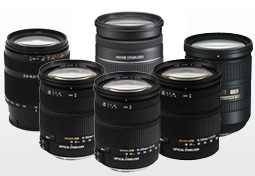18-200 mm: general presentation
What are the interesting features of these lenses?
- Inexpensive and light: if you care about price and weight, these lenses are for you
- Stabilized: these models feature stabilizers which are especially useful on large focals
- Performance: their performance is not too bad as ‘everyday’ zooms
What are their limitations?
- Speed: these lenses are a tad slow: the wider aperture of 3.5 at the minimum focal (18mm), and an even slower 6.3 at 200mm (except the Canon 18-200 and Nikon 18-200 which feature 5.6 at 200mm). This means that these lenses are best when used on good lighting conditions. If you are on a darker place you will have to increase the ISO or the exposure time.
- Image quality: these super zooms do not rank in the same class as primes or heavier (and more expensive) lenses.
Once you are aware of these limitations, you’ll be able to find a good compromise and maybe you will agree with us that “you get you pay for.”
18-200 mm lenses: results overview
DxOMark score:
As explained before, these lenses are not designed to provide the best results in low lighting conditions, so do not be surprised if you find their scores to be low.
The DxOMark scores for these seven lenses are very close and range from 5 (Sony DT 18-200mm mounted on the Sony A350 to 13 for the Sigma 18-200mm F3.5-6.3 DC OS Canon mounted on the Canon EOS 7D.
We want to point out that the Sigma 18-200mm OS score is a pretty good one for this kind of lens.
Resolution:
On resolution metrics, their results are very close as well. The Sony DT 18-200mm is the least sharp (37 lp.mm) of all. The others, such as the Nikon AF-S DX VR Zoom-Nikkor 18-200mm f/3.5-5.6G IF-ED achieve results close to 41 lp/mm.
All the results correspond to the lenses being mounted on the cameras with the best resolution available at this time on the DxOMark database:
- The Canon EOS 7D for Canon lenses
- The Nikon D7000 for Nikon lenses
- The Sony A350 for Sony lenses
Vignetting and Chromatic aberration:
Vignetting remains very well controlled on every lens, which is no great feat, as all the available apertures are small.
All Chromatic Aberration measurements show similar results except for the Sony 18-200mm at 200mm and the Sigma 18-200mm OS Nikon mount.
Distortion:
All lenses in this review present very close results on distortion: strong distortion at 18 mm and pretty well controlled for the focal superior to 50mm.
The DxOMark team selection: Which super-zoom for my Canon APS-C camera?
- Tamron 18-270mm F/3.5-6.3 Di II VC PZD: The latest Tamron 18-270mm PZD is reviewed here. Mounted on Canon cameras, this lens provides very good results at a very interesting price.
- Sigma 18-200mm F3.5-6.3 DC OS: This lens has good results at 18 and keeps them up to 200.
- Sigma 18-250mm F3.5-6.3 DC OS HSM Canon: This lens provides similar results as for the Sigma 18-200mm.
- Canon EF-S 18-200mm_f/3.5-5.6 IS: It is worth noting that this Canon lens has a very homogenous resolution on the whole focal range. It is the only lens that provides the same resolution at the center from 18 mm to 200mm.
If you would like more choices, here are some interesting comparisons for super-zoom lenses on Canon APS-C cameras:
- Tamron 18-270mm F/3.5-6.3 Di II VC PZD vs Sigma 18-250mm F3.5-6.3 DC OS HSM Canon mounted on a Canon EOS 7D
- Tamron 18-270mm F/3.5-6.3 Di II VC PZD vs Sigma 18-200mm F3.5-6.3 DC OS mounted on a Canon EOS 50D
- Sigma 18-200mm F3.5-6.3 DC OS vs Sigma 18-200mm F3.5-6.3 DC mounted on a Canon EOS 50D
- Canon EF-S 18-200mm_f/3.5-5.6 IS vs Sigma 18-200mm F3.5-6.3 DC OS mounted on a Canon EOS 500D
- Canon EF-S 18-200mm_f/3.5-5.6 IS vs Tamron AF 18-270mm F/3.5-6.3 Di II VC LD Aspherical [IF] Macro Canon mounted on a Canon EOS 350D
The DxOMark team selection: Which super zoom for my Nikon APS-C camera?
- Sigma 18-200mm F3.5-6.3 DC OS
- Tamron AF 18-270mm F/3.5-6.3 Di II VC LD Aspherical [IF] Macro Nikon
- Tamron 18-270mm F/3.5-6.3 Di II VC PZD Nikon
- Sigma 18-250mm F3.5-6.3 DC OS HSM Nikon
- Nikon AF-S DX VR Zoom-Nikkor 18-200mm f/3.5-5.6G IF-ED
Surprisingly, we have a tie here: the DxOMark score ranges only from 8 to 9 for all 5 lenses, so they all should provide satisfactory images. Their features are also pretty similar (same aperture and stabilization for every model).
Note that the previous version of the Tamron 18 -270 achieves a better resolution metric: 44 lp.mm.
The best choice might be either the inexpensive Sigma 18-250mm F3.5-6.3 DC OS HSM Nikon or the light Tamron 18-270mm F/3.5-6.3 Di II VC PZD Nikon.
For further information, here are some interesting comparisons for super-zoom lenses on Nikon APS-C cameras:



DXOMARK encourages its readers to share comments on the articles. To read or post comments, Disqus cookies are required. Change your Cookies Preferences and read more about our Comment Policy.